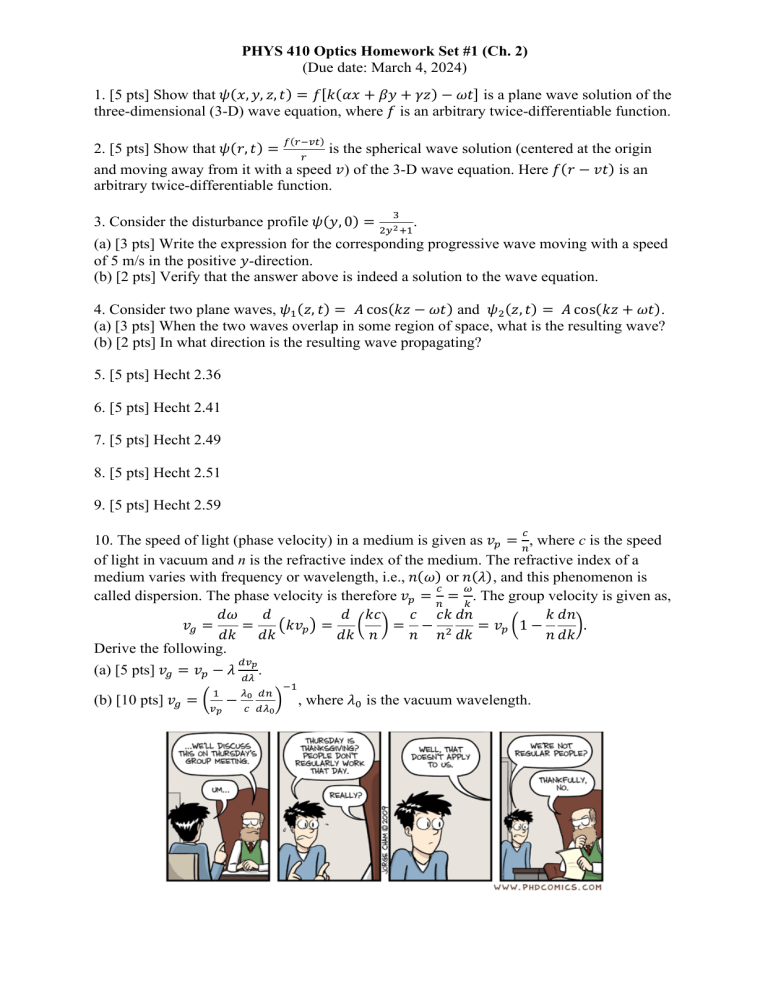
PHYS 410 Optics Homework Set #1 (Ch. 2) (Due date: March 4, 2024) 1. [5 pts] Show that 𝜓(𝑥, 𝑦, 𝑧, 𝑡) = 𝑓 [𝑘(𝛼𝑥 + 𝛽𝑦 + 𝛾𝑧) − 𝜔𝑡] is a plane wave solution of the three-dimensional (3-D) wave equation, where 𝑓 is an arbitrary twice-differentiable function. !(#$%&) 2. [5 pts] Show that 𝜓(𝑟, 𝑡) = # is the spherical wave solution (centered at the origin and moving away from it with a speed 𝑣) of the 3-D wave equation. Here 𝑓(𝑟 − 𝑣𝑡) is an arbitrary twice-differentiable function. ( 3. Consider the disturbance profile 𝜓(𝑦, 0) = )* ! +,. (a) [3 pts] Write the expression for the corresponding progressive wave moving with a speed of 5 m/s in the positive 𝑦-direction. (b) [2 pts] Verify that the answer above is indeed a solution to the wave equation. 4. Consider two plane waves, 𝜓, (𝑧, 𝑡) = 𝐴 cos(𝑘𝑧 − 𝜔𝑡) and 𝜓) (𝑧, 𝑡) = 𝐴 cos(𝑘𝑧 + 𝜔𝑡). (a) [3 pts] When the two waves overlap in some region of space, what is the resulting wave? (b) [2 pts] In what direction is the resulting wave propagating? 5. [5 pts] Hecht 2.36 6. [5 pts] Hecht 2.41 7. [5 pts] Hecht 2.49 8. [5 pts] Hecht 2.51 9. [5 pts] Hecht 2.59 . 10. The speed of light (phase velocity) in a medium is given as 𝑣- = /, where c is the speed of light in vacuum and n is the refractive index of the medium. The refractive index of a medium varies with frequency or wavelength, i.e., 𝑛(𝜔) or 𝑛(𝜆), and this phenomenon is . 0 called dispersion. The phase velocity is therefore 𝑣- = / = 1 . The group velocity is given as, 𝑑𝜔 𝑑 𝑑 𝑘𝑐 𝑐 𝑐𝑘 𝑑𝑛 𝑘 𝑑𝑛 𝑣2 = = ?𝑘𝑣- @ = A C= − ) = 𝑣- A1 − C. 𝑑𝑘 𝑑𝑘 𝑑𝑘 𝑛 𝑛 𝑛 𝑑𝑘 𝑛 𝑑𝑘 Derive the following. 3% (a) [5 pts] 𝑣2 = 𝑣- − 𝜆 34" . , 4# 3/ " . 34# (b) [10 pts] 𝑣2 = A% − $, C , where 𝜆5 is the vacuum wavelength.


